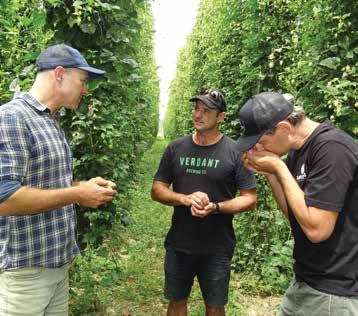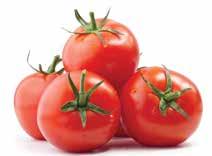
6 minute read
Country’s largest hop grower continues to expand
COUNTRY’S LARGEST HOP GROWER
CONTINUES TO EXPAND
Words by Anne Hardie
General manager of operations, Paul Teen, checks out the crop with Glen Clayton (centre) and Brian Clayton Brian (left), Paul Teen and Glen above a river terrace at their Battery Hill hop farm
Not so many years ago the Clayton brothers knew nothing about hops apart from the aroma and flavours they instilled in a craft beer. Today they are the country’s largest hop growers and still expanding.
Last year they produced close to 250 tonnes of hops for brewers around the world, and by the time their farms are fully developed that is expected to climb to about 1,000 tonnes from 500ha.
The three brothers, Brian, Glen and Andrew, originate from the West Coast where their parents still farm, and each left the farm for university and careers away in agricultural finance or in Brian’s case, commercial law.
For several years they had been seeking a venture together and when Andrew started planting hops to establish his own hop farm, they realised the potential for something bigger. Not only was it a venture that matched their skills set of finance and development, but Brian says it was a product that craft brewers wanted.
“Our (New Zealand) hops are coveted around the world and we’re only 1% of the world’s hops. To us, the fundamentals were there. We’re pretty passionate about it and feel at the end of the day we want to see where it can go, because it’s a great product and there’s not much of it around. Let’s see if we can do it justice.” This is their third harvest – and Andrew’s fourth – on properties they purchased and developed near Tapawera and Korere, west of Nelson. So far, 240ha on three former dairy farms and one sheep and beef farm have sprouted poles on river flats, terraces and plateaus, with 260ha yet to develop. In the midst of the plantings, a couple of $7 million processing and kiln facilities have been built to strip the cones from the vines (or bines) and dry them, ready for brewers. “Demand is there and we feel there’s room for everyone. One variety in the United States, Citra, is bigger than the whole New Zealand crop. It dwarfs the whole New Zealand industry.” They grow nine varieties of hops on their farms, being a combination of highly popular hop varieties as well as lesser-known varieties that spread the season. That enables them to harvest each variety at the optimum time for quality and also utilise the processing and kiln facilities as long as possible. Among their varieties is the ‘rock star’ of the New Zealand hop industry, Nelson Sauvin, plus Motueka, which have the aromas and tastes that brewers love. Brian refers to the variety Riwaka as the holy grail because it is a great brewer’s hop, but can be temperamental to grow, which from a brewer’s perspective means it can be hard to get their hands on.

He credits the work of New Zealand Hops and the plant breeding programme of Plant & Food Research, which has produced outstanding varieties. Brian says the challenge in breeding is pushing out the harvest window – in addition to producing new hops that brewers love. Last year New Zealand Hops released its latest new variety, Nectaron, which has intense tropical passionfruit and citrus aroma characteristics.
“The plant breeding programme has put New Zealand on the world stage because they have produced some amazing hops. If you have a great product, you are going to sell it.” This season represents a step change in production for the farms which are operating two eight-hour shifts during harvest. The first shift works between 6am and 2pm and the second from 2pm through to 10pm. That enables them to harvest five to six hectares a day as each variety hits its harvest window.
The crop is looking the best yet as plants mature, and following good growing conditions this season. Brian says it has been a steep learning curve for the entire team and admits it has been harder than they thought to grow a crop of hops and harvest it. “Local growers have been so helpful to us and the cooperative has things in place for new growers – they want you to do well.” Because they have established new hop farms, they have been able to use some of the latest growing methods, and hence they have been one of the first to install drip line irrigation rather than overhead irrigation. The irrigation is more efficient and targeted to each plant and can deliver fertiliser to each as well.
Finding enough seasonal staff is a challenge for an operation based more than an hour from major settlements. Peak times are spring when vines are attached (trained) to the strings for them to climb, plus harvest from about mid-February through March. When the operation is fully developed, they will need about 200 workers at harvest. Finding accommodation for staff in a reasonably remote rural setting has been a challenge and so has Covid-19. So far, they have had a mixture of locals and backpackers and he says they have made sure they are proactive about sourcing staff, and there has been good collaboration with other growers to share resources. The craft beer market has been challenging during Covid-19 and Brian says an estimated 80–85% of Kiwi hops are exported to countries such as the United States, United Kingdom, European Union, Australia and Asia. Many craft brewers have hunkered down and therefore sales have slowed, he says. It has also been more difficult to get in front of potential new customers with travel being ruled out. “But we just have to keep pushing. We are lucky that processed hops don’t perish, and we expect to see an uptick in brewer interest later this year as the vaccines are rolled out and the Northern Hemisphere summer comes into play.
2021 Horticulture New Zealand Director Elections
Calling for Nominations for Two Directors
The Horticulture New Zealand constitution provides for a term of three years for elected directors with one third of directors retiring by rotation each year. The following Directors retire by rotation this year.
Bernadine Guilleux is offering herself for re-election Mike Smith is not seeking re-election
In accordance with Clause 12 (e) of the Horticulture New Zealand Constitution nominations are now being sought from individual grower members, affiliated Product Groups and affiliated Grower Associations. Candidates must be nominated by at least two grower members or affiliated organisations. The election is based on electing the best people for the job with no allocated seats for product, sector or regional representatives.
Candidate criteria
Nominated candidates must be: • a person who is an active grower member of
HortNZ; or • a director, shareholder, partner or trustee of an active grower member who is appointed by that member as the principal representative of the entity in their dealings with HortNZ; or • an employee of an active grower member who is appointed by that member as the principal representative of the entity in their dealings with
HortNZ. If more than two (2) candidates are nominated, an election will be held where individual grower members will vote for their preferred candidates. A profile for each candidate will be included with the voting papers distributed to growers.
The nomination form and position description is available on HortNZ’s website www.hortnz.co.nz or can be requested from the Board Secretary via email Kerry.Norman@hortnz.co.nz or by phone 0508 467 869.










